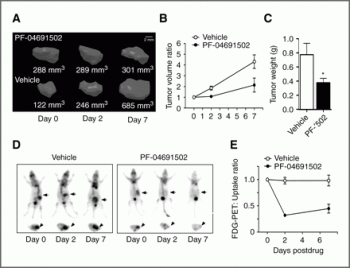| CAS NO: | 1013101-36-4 |
| 规格: | ≥98% |
| 包装 | 价格(元) |
| 5mg | 电议 |
| 25mg | 电议 |
| 50mg | 电议 |
| 100mg | 电议 |
| 250mg | 电议 |
| 500mg | 电议 |
| Molecular Weight (MW) | 425.48 |
|---|---|
| Formula | C22H27N5O4 |
| CAS No. | 1013101-36-4 |
| Storage | -20℃ for 3 years in powder form |
| -80℃ for 2 years in solvent | |
| Solubility (In vitro) | DMSO: 14 mg/mL (32.9 mM) |
| Water:<1 mg/mL | |
| Ethanol: <1 mg/mL | |
| Synonym | PF-04691502; PF 04691502; PF04691502; PF 4691502; PF4691502; PF-4691502 |
| Chemical Name | 2-amino-8-[4-(2-hydroxyethoxy)cyclohexyl]-6-(6-methoxypyridin-3-yl)-4-methylpyrido[2,3-d]pyrimidin-7-one |
In Vitro | Kinase Assay: The fluorescence polarization assay for ATP competitive inhibition is done as follows: mPI3Kα dilution solution (90 nM) is prepared in fresh assay buffer (50 mM Hepes pH 7.4, 150 mM NaCl, 5 mM DTT, 0.05% CHAPS) and kept on ice. The enzyme reaction contains 0.5 nM mouse PI3Kα (p110α/p85α complex purified from insect cells), 30 μM PIP2, PF-04691502 (0, 1, 4, and 8 nM), 5 mM MgCl2, and 2-fold serial dilutions of ATP (0–800 μM). Final dimethyl sulfoxide is 2.5%. The reaction is initiated by the addition of ATP and terminated after 30 minutes with 10 mM EDTA. In a detection plate, 15 uL of detector/probe mixture containing 480 nM GST-Grp1PH domain and 12 nM TAMRA tagged fluorescent PIP3 in assay buffer is mixed with 15 uL of kinase reaction mixture. The plate is shaken for 3 minutes, and incubated for 35 to 40 minutes before reading on an LJL Analyst HT.
Cell Assay: BT20, U87MG, and SKOV3 cells are plated at 3,000 cell/well in 96-well culture plates in growth medium with 10% FBS. Cells are incubated overnight and treated with DMSO (0.1% final) or serial diluted compound for 3 days. Resazurin is added to 0.1 mg/mL. Plates are incubated at 37 °C in 5% CO2 for 3 hours. Fluorescence signals are read as emission at 590 nm after excitation at 530 nm. IC50 values are calculated by plotting fluorescence intensity to drug concentration in nonlinear curve. PF-04691502 potently inhibits recombinant class I PI3K and mTOR in biochemical assays and suppresses transformation of avian fibroblasts mediated by wild-type PI3K γ, δ, or mutant PI3Kα. In PIK3CA-mutant and PTEN-deleted cancer cell lines, PF-04691502 reduces phosphorylation of AKT T308 and AKT S473 (IC(50) of 7.5-47 nM and 3.8-20 nM, respectively) and inhibits cell proliferation (IC(50) of 179-313 nM). PF-04691502 inhibits mTORC1 activity in cells as measured by PI3K-independent nutrient stimulated assay, with an IC(50) of 32 nM and inhibits the activation of PI3K and mTOR downstream effectors including AKT, FKHRL1, PRAS40, p70S6K, 4EBP1, and S6RP. Short-term exposure to PF-04691502 predominantly inhibits PI3K, whereas mTOR inhibition persists for 24 to 48 hours. PF-04691502 induces cell cycle G(1) arrest, concomitant with upregulation of p27 Kip1 and reduction of Rb. |
In Vivo | Antitumor activity of PF-04691502 is observed in U87 (PTEN null), SKOV3 (PIK3CA mutation), and gefitinib- and erlotinib-resistant non-small cell lung carcinoma xenografts. PF-04691502 inhibits tumor growth at 7 days by 72%. FDG-PET imaging revealed that PF-04691502 reduces glucose metabolism dramatically. Tissue biomarkers of PI3K/mTOR pathway activity, p-AKT (S473), and p-RPS6 (S240/244), are also dramatically inhibited following PF-04691502 treatment. |
Animal model | LSL-KrasG12D heterozygous mice (B6.129-Kras tm4Tyj) and Ptendel mice (c;129S4-Pten tm1Hwu/J), Orthotopic transplant of ovarian tumors |
Formulation & Dosage | Dissolved in 0.5% methylcellulose; 10 mg/kg; oral |
References | [1] Yuan J, Mol Cancer Ther, 2011, 10(11), 2189-2199; [2] Kinross KM, Mol Cancer Ther, 2011, 10(8), 1440-1449. |
Kinross KM, Mol Cancer Ther, 2011, 10(8), 1440-1449 |  |  |
